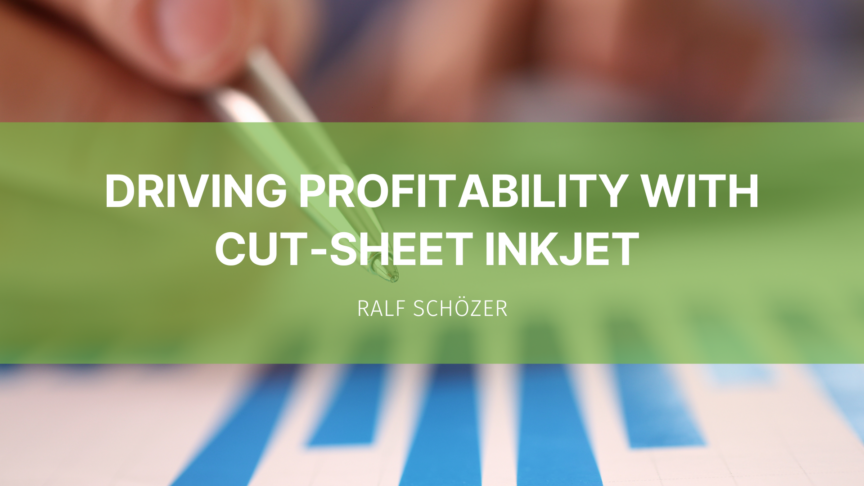Sponsored by Kyocera
New technology can open opportunities in a changing market, for example, sheet-fed inkjet in direct marketing. Direct mail is a thriving form of advertising and, after a brief dip during the pandemic, volumes and revenues keep rising again. While social media garnered a lot of publicity during the pandemic, marketers are reconsidering their stance based on the effectiveness of direct mail. According to the latest ANA Response Report from 2023, direct mail letters average a 43% ROI. Furthermore, 74% of marketers said that direct mail delivers the best ROI of any channel, according to Lob’s 2023 State of Direct Mail report.
The direct mail market is changing, however. Rising postal and production costs require marketers to use more intelligent ways to achieve more impact for their budget. Runs are getting shorter but each mailing is much closer targeted. Intelligent composition tools allow for better personalization or versioning, while a high-quality variable data printer is needed to put images and copy onto paper. It can be difficult, however, to justify an investment in a roll-fed inkjet printer with sufficient print quality. Taking advantage of the shorter-run opportunities often requires a high-quality, but affordable digital color printing solution. This is where the Kyocera TASKalfa Pro 15000c excels.
L&E Meridian growing with inkjet
Direct mail specialist L&E Meridian was founded 37 years ago and has grown to a company employing 115 today. The company relied on a number of cut-sheet and roll-fed toner presses for personalization and addressing, while offset preprint was outsourced.
More recently L&E Meridian discovered that customers are getting more discriminating in their direct marketing spend. Rising postal costs are causing customers to lower quantities but increase targeting and versioning. In March 2020, the company decided to invest in a version of the Kyocera TASKalfa Pro 15000c, sold by distribution partner MCS, to complement their monochrome and color toner printers with fully variable inkjet printing. Shortly afterwards L&E Meridian invested even in a second press.
A number of factors made the Kyocera solution a preferable production tool. The investment is much lower compared to a roll-fed inkjet press. Production capacity can be added more incrementally, while multiple devices allow for redundancy. Print quality and paper range were a great fit.
The printers did not only fulfill, they surpassed expectations. The low running costs made it possible to replace offset preprint and toner imprinting with a flexible and streamlined white paper solution and to bring more of the value chain in-house. The added benefit was lowering the stock level of preprint and better control of paper types, stock levels, and the supply chain in general. At the same time, the turnaround times lowered considerably from more than a week to just one day – an incredible advantage when competing for ad-hoc mailing budgets.
L&E Meridian found that the cut-sheet inkjet option stacked up very well against their roll-fed toner printers. Initially aimed for runs of several thousand copies, the printer now routinely prints runs of more than 100,000 copies as well. L&E Meridian is operating their cut-sheet inkjet presses in a three-shift operation, producing more than 1.5 million impressions per month on each printer. Despite the heavy workload, the presses run reliably and the low maintenance requirements help to keep the printers running.
Kyocera’s cut-sheet inkjet technology allows L&E Meridian to continue on its steady growth path. Profitability improved as well. While maintaining the same quality level, switching to inkjet resulted in a noticeably lower running cost compared to the existing toner systems. Reducing the need for preprint led to significantly simpler logistics, more control over processes, and greater flexibility. It also improved the profitability of the roll-fed toner press as reruns or extra copies can be printed on the cut-sheet devices much more efficiently. Getting close to maximum capacity, L&E Meridian is now considering adding a third cut-sheet printer.

Installation at L&E Meridian
A fit for all sizes
Kyocera US is seeing vigorous interest among direct mail producers in the TASKalfa Pro 15000c, with about half of all installations of the device in the direct mail sector so far. The printer has not only a superb price-performance ratio, it also offers a very affordable entry into production color inkjet printing. Kyocera reports that the press can consistently hit G7 color targets on offset uncoated stock. This allows high-speed fully variable color printing at volume levels a roll-fed solution is not suitable. However, even high-volume mailers are eagerly taking up the TASKalfa Pro 15000c – as a backup or reprint device for their roll-fed solutions. The compact size of the printer, the ability to quickly change papers, and the low power consumption result in a printer that can fit in almost any environment. Users like L&E Meridian prove that the printer is capable of reliably running more than a million impressions per month.
Despite all the technical capabilities it needs to be stressed, however, that the Kyocera TASKalfa Pro 15000c is not just an advanced piece of technology, it is a solution to solve business challenges. Direct mail is evolving, requiring full color, and high-quality inkjet in short runs, with quick turnover times. Marketers are willing to allocate their budgets to channels with a good ROI, however, a cost-efficient production process remains a key to being able to offer these services profitably.
This article was sponsored by Kyocera

